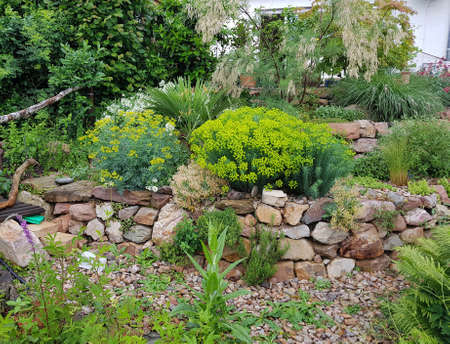Introduction to Raised Beds and Terracing in Rock Gardens
Raised beds and terracing have become increasingly popular features in American-style rock garden designs, offering both aesthetic appeal and practical advantages. By elevating planting areas above the native soil, raised beds provide better drainage, improved soil control, and easier access for gardeners of all ages. Similarly, terracing enables homeowners to transform sloped or uneven terrain into usable and visually dynamic spaces. These techniques not only enhance the beauty of a rock garden but also address many common landscaping challenges found in various U.S. regions, such as poor soil quality or water runoff issues.
Incorporating raised beds and terraces allows gardeners to highlight the unique textures and colors of rocks and alpine plants, creating multi-dimensional focal points that capture attention throughout the year. The flexibility of these methods fits seamlessly into diverse American landscapes—from suburban backyards to rural properties—making them ideal for gardeners seeking low-maintenance yet striking garden solutions. The chart below summarizes some key benefits and distinctive characteristics of raised beds and terracing in rock gardens:
| Feature | Raised Beds | Terracing |
|---|---|---|
| Soil Control | Excellent (customizable soil mixes) | Improved on slopes (prevents erosion) |
| Drainage | Superior (prevents root rot) | Manages water flow efficiently |
| Aesthetic Value | Defined structure, elevated displays | Layered visual interest, dramatic effect |
| Accessibility | Easier maintenance (less bending) | Pathways can be integrated for easy access |
| Adaptability to Terrain | Works on flat or slightly sloped ground | Ideal for steep or irregular landscapes |
The integration of raised beds and terracing brings together functionality and style, making them essential elements in modern American rock garden design. Whether you are looking to maximize plant diversity or simply add visual intrigue to your yard, these techniques offer versatile solutions that suit a wide range of gardening goals and local conditions.
2. Choosing the Right Materials and Location
When planning raised beds and terracing for your rock garden, selecting the proper materials and evaluating the best site conditions are essential steps for long-term success. Using locally sourced stone not only enhances the natural look of your garden but also ensures the materials blend seamlessly with the surrounding landscape. Pressure-treated lumber is another popular choice in American gardens, valued for its durability and resistance to rot—particularly important when constructing raised beds that need to withstand varying weather conditions.
Recommended Materials for Raised Beds and Terraces
| Material | Benefits | Considerations |
|---|---|---|
| Locally Sourced Stone | Natural appearance, blends with landscape, highly durable | Can be heavy, may require professional installation |
| Pressure-Treated Lumber | Cost-effective, easy to work with, rot-resistant | Must ensure safe treatment chemicals; edges may need extra reinforcement |
| Recycled Concrete (Urbanite) | Sustainable, affordable, gives a modern look | Irregular shapes can complicate stacking; check for contaminants |
Evaluating Site Conditions
Selecting the right location is just as crucial as choosing materials. For optimal plant growth and drainage, observe your yard throughout the day to assess sunlight exposure—most rock garden plants prefer at least 6 hours of direct sun. Drainage is key: avoid low-lying areas where water tends to pool after rainstorms, as most alpine or drought-tolerant species dislike “wet feet.” If necessary, consider amending soil or building up areas with gravel to improve drainage before construction.
Site Evaluation Checklist
- Sunlight: Minimum 6 hours of direct sun daily
- Drainage: Well-drained soil or ability to amend with sand/gravel
- Slope: Gentle slopes work well for terracing; steep slopes may need more support
- Accessibility: Close enough for easy watering and maintenance
Tip:
If you’re unsure about drainage, dig a small hole and fill it with water. If it drains within an hour, your spot is likely suitable for a rock garden raised bed or terrace.

3. Building Raised Beds for Your Rock Garden
Step-by-Step Guide to Constructing Durable Raised Beds
Raised beds are a cornerstone of successful rock garden design, especially in American landscapes where soil quality and space can vary widely. Here’s a straightforward guide to building raised beds that will stand the test of time:
- Choose the Right Location: Select a spot that receives at least 6 hours of sunlight daily and has good drainage.
- Select Materials: Popular options in the U.S. include cedar, redwood, stone, or recycled composite lumber for longevity and sustainability.
- Determine Bed Dimensions: Keep beds no wider than 4 feet for easy access from all sides, and height between 12-24 inches depending on plant root depth.
- Prepare the Site: Remove grass and weeds, then level the area. Lay down landscape fabric if needed to prevent weed growth.
- Assemble the Frame: Securely connect corners with galvanized screws or brackets to withstand seasonal changes.
- Add Drainage Layer: Place a layer of gravel or small rocks at the bottom to promote drainage—especially important in wetter regions like the Pacific Northwest.
- Fill with Quality Soil Mix: Use a blend of topsoil, compost, and sand or grit for excellent drainage and fertility tailored to your region’s native plants.
Tips for Maximizing Space and Soil Health
- Vertical Planting: Incorporate upright stones or trellises to grow alpine plants or trailing succulents vertically, saving ground space.
- Companion Planting: Pair drought-tolerant species together to optimize watering needs and reduce disease risk.
- Crop Rotation: Change plant locations each year to maintain soil nutrients and minimize pest buildup.
Soil Mix Recommendations by U.S. Region
| Region | Main Considerations | Recommended Soil Mix |
|---|---|---|
| Northeast | Poor native drainage; cold winters | Topsoil, compost, coarse sand, pine bark fines |
| Southeast | Heavy clay soils; humid climate | Sandy loam, composted leaf mold, expanded shale |
| Midwest | Poor native fertility; hot summers | Mushroom compost, topsoil, pea gravel for drainage |
| Southwest/West Coast | Drought conditions; alkaline soils | Cactus mix, decomposed granite, organic matter |
| Pacific Northwest | High rainfall; acidic soils | Sandy loam, compost, pumice or perlite for aeration |
Pro Tip:
If you’re building multiple raised beds for a larger rock garden design, stagger their heights and orientations to create natural-looking elevation changes reminiscent of native American rock outcroppings.
4. Designing Effective Terracing on Sloped Terrain
Transforming a sloped yard into a beautiful and practical rock garden often requires thoughtful terracing. Properly designed terraces not only add visual interest but also help manage water runoff and prevent soil erosion—key concerns in many American landscapes. Here are essential strategies for creating stable and attractive terraces:
Key Strategies for Stable Terracing
| Strategy | Description | Benefits |
|---|---|---|
| Retaining Walls | Use materials like natural stone, concrete blocks, or timber to build strong retaining walls that support each terrace level. | Prevents soil movement, offers planting pockets, and complements the natural look of rock gardens. |
| Proper Grading | Ensure each terrace is slightly pitched (about 2% slope) away from retaining walls for effective drainage. | Minimizes water pooling and reduces pressure on walls, protecting your garden investment. |
| Erosion Control | Install landscape fabric beneath gravel or mulch, and use groundcovers or low-growing perennials on slopes. | Stabilizes soil, reduces weed growth, and enhances the layered appearance of your garden. |
Advice on Retaining Walls for Rock Gardens
Retaining wall selection: For American yards, natural stone is a popular choice due to its rustic charm and durability, while concrete block systems offer a modern touch and easy installation. Always check local building codes; in many states, walls over 3-4 feet may require professional engineering.
Drainage considerations: Incorporate perforated pipes (French drains) behind retaining walls to direct excess water away from the structure. Backfill with gravel to promote quick drainage and further reduce hydrostatic pressure.
Proper Grading Techniques
- Step the slope: Divide steep grades into several smaller terraces instead of one large wall for greater stability and easier planting access.
- Slope each terrace: Maintain a gentle grade toward the front edge to avoid water buildup near the base of plants or walls.
- Create planting pockets: Leave space between rocks or blocks for drought-tolerant plants like sedums, creeping phlox, or native grasses commonly found across U.S. regions.
Erosion Control Methods
- Add mulch or gravel: Cover exposed soil with decorative gravel or shredded bark to slow down runoff and keep roots cool during hot American summers.
- Select erosion-fighting plants: Choose deep-rooted natives such as prairie dropseed or blue grama grass in Midwest gardens, or succulents like ice plant for drier Western slopes.
- Install check dams: In areas prone to heavy rain, small boulders placed at intervals can further slow water flow and trap sediment.
Sustainable Tip:
If you’re working with an existing slope, try to minimize disturbance by designing terraces that follow the land’s natural contours. This approach saves labor and preserves the unique character of your landscape—a principle highly valued in American gardening culture.
5. Selecting and Arranging Plants
When designing a rock garden using raised beds and terracing, selecting the right plants is key to creating a thriving and visually appealing landscape. In the U.S., prioritizing drought-tolerant and native species helps conserve water and supports local ecosystems. Raised beds and terraces offer excellent drainage, which is ideal for many rock garden favorites that dislike soggy roots.
Best Practices for Choosing Plants
| Plant Type | Why It Works | Examples |
|---|---|---|
| Drought-Tolerant Perennials | Survive with less water, perfect for sunny, well-drained rock gardens | Lavender, Sedum, Blanket Flower (Gaillardia) |
| Native Wildflowers | Adapted to local climate and support pollinators | Black-Eyed Susan (Rudbeckia), Purple Coneflower (Echinacea) |
| Low-Growing Groundcovers | Help retain soil on slopes and fill gaps between rocks | Creeping Thyme, Ice Plant (Delosperma) |
| Ornamental Grasses | Add movement and texture year-round | Blue Fescue, Little Bluestem |
| Dwarf Evergreens | Provide structure and winter interest | Dwarf Mugo Pine, Juniper ‘Blue Star’ |
Arranging for Four-Season Interest
- Layer Heights: Place taller plants toward the back or higher terraces, cascading down with medium and low growers at the front or lower tiers. This maximizes visibility and sunlight exposure for all plants.
- Mix Textures & Colors: Combine spiky grasses, mounding perennials, and ground-hugging succulents. Use foliage color contrasts—silvery lamb’s ear next to deep green sedges, for example—for visual pop.
- Stagger Bloom Times: Choose plants with varying bloom periods to ensure year-round color. Early spring bulbs (like crocus), summer-blooming coneflowers, fall asters, and evergreen shrubs can keep your garden lively every season.
- Utilize Microclimates: Raised beds and terraces may have warmer or cooler pockets—sunny spots suit cacti or sedums, while shady corners favor ferns or mosses.
- Create Naturalistic Groupings: Cluster similar plants in odd numbers (three or five) for a more organic look rather than lining them up in rows.
Drought-Tolerant & Native Plant Suggestions by U.S. Region
| Region | Drought-Tolerant Natives |
|---|---|
| Northeast/Midwest | Purple Coneflower, Prairie Dropseed Grass, Butterfly Weed |
| Southeast | Coreopsis, Eastern Bluestar, Little Bluestem Grass |
| Southwest/West Coast | Pineleaf Penstemon, California Poppy, Blue Grama Grass |
| Mountain West/Rockies | Bluemat Penstemon, Blanket Flower, Sulphur Buckwheat |
| Pacific Northwest | Kinnikinnick, Oregon Stonecrop, Red Flowering Currant |
A Few Extra Tips:
- Avoid overcrowding; leave room for mature plant size.
- Add mulch or gravel around plant bases to reduce evaporation and prevent weeds.
- If you’re unsure about plant selection, consult your local extension office or native plant society for region-specific advice.
6. Care and Maintenance
Proper care and maintenance are key to keeping your raised beds and terraced rock gardens thriving for years to come, especially in the diverse climates found across the United States. Understanding routine tasks such as watering, pruning, and soil amendment will help maintain the long-term health of your garden.
Routine Maintenance Recommendations
Regular maintenance ensures that your rock garden remains both beautiful and healthy. Below is a table outlining essential tasks and recommended frequencies:
| Task | Frequency | Best Practices |
|---|---|---|
| Watering | 1-2 times per week (varies by region & season) | Water deeply at the base of plants; avoid overhead watering to prevent fungal diseases. |
| Weeding | Weekly or as needed | Hand-pull weeds regularly to reduce competition for nutrients and water. |
| Pruning | Seasonally or as needed | Remove dead, damaged, or overgrown branches to encourage healthy growth. |
| Soil Amendment | Annually in spring or fall | Add compost or well-rotted manure to replenish nutrients. |
| Mulching | 1-2 times per year | Apply gravel or organic mulch to retain moisture and suppress weeds. |
| Pest & Disease Check | Monthly or as needed | Inspect plants for signs of trouble; use organic or local-approved solutions for control. |
Watering Techniques for Raised Beds and Terraces
The elevated design of raised beds and terraces means they often drain faster than traditional ground beds, especially in arid U.S. regions. Use soaker hoses or drip irrigation systems for efficient water delivery right at the roots. Early morning is the best time to water, reducing evaporation and disease risk.
Pro Tip:
If you live in a region with frequent rainfall, monitor soil moisture levels before watering to avoid root rot.
Pruning Strategies for Rock Garden Plants
Selective pruning encourages compact growth and helps maintain the natural shape of your rock garden plants. Remove spent blooms (deadheading) from perennials and trim back leggy growth after flowering. For evergreens, prune lightly in late winter or early spring before new growth starts.
Soil Amendments for Long-Term Health
The rocky substrate in these gardens can become depleted over time. Each year, top-dress with compost or incorporate slow-release organic fertilizers suited to your plant choices. In areas with alkaline soils common in the western U.S., consider adding peat moss or elemental sulfur to adjust pH if necessary.
Sustainable Practices:
Avoid synthetic chemicals whenever possible—opt for organic amendments and integrated pest management (IPM) strategies to support local pollinators and wildlife.
By following these care guidelines, your raised bed and terraced rock garden will continue to flourish, offering beauty and ecological value season after season across any American landscape.
7. Inspiration and Finishing Touches
Once your raised beds and terracing are in place, it’s time to add those special touches that make your rock garden uniquely yours. Incorporating decorative elements not only adds visual interest but also enhances the functionality and enjoyment of your outdoor space. Here are some American-inspired ideas to help you bring both personality and practicality to your rock garden design.
American Garden Art
From whimsical metal sculptures to rustic birdhouses, garden art is a fantastic way to showcase your personality. Choose pieces that reflect local culture or your own interests—think vintage farm tools, patriotic motifs, or Native American pottery. Place these accents where they can be enjoyed from pathways or seating areas for maximum impact.
Pathways for Exploration
Well-designed pathways invite guests to explore and provide easy access for maintenance. Consider using locally sourced materials such as flagstone, gravel, or reclaimed bricks for a touch of Americana. Below is a table outlining popular pathway options and their benefits:
| Pathway Material | Style Influence | Benefits |
|---|---|---|
| Flagstone | Classic American | Natural look, durable, slip-resistant |
| Gravel | Cottage & Modern | Affordable, great drainage, easy installation |
| Reclaimed Brick | Historic/Urban | Sustainable, charming, unique character |
| Wood Mulch | Rustic/Farmhouse | Soft underfoot, blends with plantings, budget-friendly |
Inviting Seating Areas
Add comfort and encourage relaxation by incorporating seating into your rock garden. Options range from classic Adirondack chairs to built-in stone benches or even a porch swing nestled between raised beds. These spots are perfect for enjoying a morning coffee or evening sunset surrounded by your handiwork.
Tips for Personalizing Your Space:
- Add solar-powered lanterns or string lights along pathways for nighttime ambiance.
- Install a small water feature like a birdbath or fountain for soothing sounds and wildlife attraction.
- Use containers filled with native perennials to add color and flexibility.
- Display handmade stepping stones with family names or inspirational quotes.
Your Rock Garden Retreat Awaits!
The finishing touches you choose will transform your raised bed and terraced rock garden from simply functional to truly unforgettable. By blending practical features with artistic flair, you’ll create a personal retreat that reflects both American gardening traditions and your individual style.


